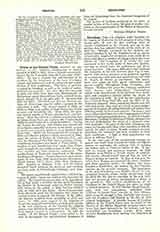

Ursula of the Blessed Virgin, SOCIETY OF THE SISTERS OF ST., religious congregation of women founded in 1606 at Dole (then a Spanish possession), France, by the Venerable Anne de Xainctonge (1587-1612). Its aim is twofold: the sanctification of its members by the observance of the vows of religion (simple and perpetual), and the salvation and sanctification of their neighbors. The latter is specially attained by teaching, as well as by works of mercy, spiritual and corporal. At a time when the education of girls was more than neglected, Mademoiselle de Xainctonge, amid extraordinary trials, realized her inspired thought to do for girls what St. Ignatius had done for boys. This idea was then an unusual one. Anne de Xainctonge may be called a pioneer in the education of girls. The classes opened at Dole, on June 16, 1606, were public, without distinction of rich or poor, and absolutely free. From Dole, the institute spread rapidly to France, Switzerland, and Germany. With the Church it suffered persecution, but on being driven from one country, the Ursules found children and freedom of teaching in another. During the French Revolution, their houses were closed and the religious compelled to return to the world; as soon as peace was restored, however, they resumed their former life. Mother de Vers reopened the convent at Dole, and Mother Roland de Bussy (formerly of Dole) upon the advice of Father de Clorivitre, S.J., and with the blessing of Pius VII (then a prisoner at Fontainebleau), founded a new house at Tours (1814). A number of new foundations were made from Tours, until, through the anti-religious laws of 1901, the nuns were expelled and their property confiscated. The motherhouse of Tours was transferred to Haverloo-lez-Bruges (Belgium). Foundations were successively made: in New York, 1901 (branch house, Providence, Rhode Island, 1911); Rome, 1904; Sluis (Holland), 1911. Besides in Belgium, Italy, and the United States of North America, the sisters are now carrying on their work in Switzerland, Germany, and England.
The society was formally approved by a Brief of Innocent X (1648), which was confirmed by Innocent XI (1678). The Constitutions are those of St. Ignatius as far as they apply to women; the first draft was begun by Mother de Xainctonge aided by Father Guyon S.J., rector of the college at Dole, but was finished only in 1623, after her death. These Constitutions were observed until the Revolution, but when the various houses reopened, the bishops of the different dioceses modified them according to their own views. In 1898, upon request of the religious of Tours, the original Constitutions, revised conformably to the new regulations of the Church for religious orders, were definitively approved by Leo XIII, and their branch erected as a generalate. In 1902 the words, “Of the Blessed Virgin”, were added to the title to distinguish the non-cloistered daughters of Anne de Xainctonge from the cloistered daughters of St. Angela.
The system of teaching employed by the order is similar to that of the Jesuits; the plan of studies conforms to the requirements of the Board of Education in each country.
MOTHER HELENE MARIE

